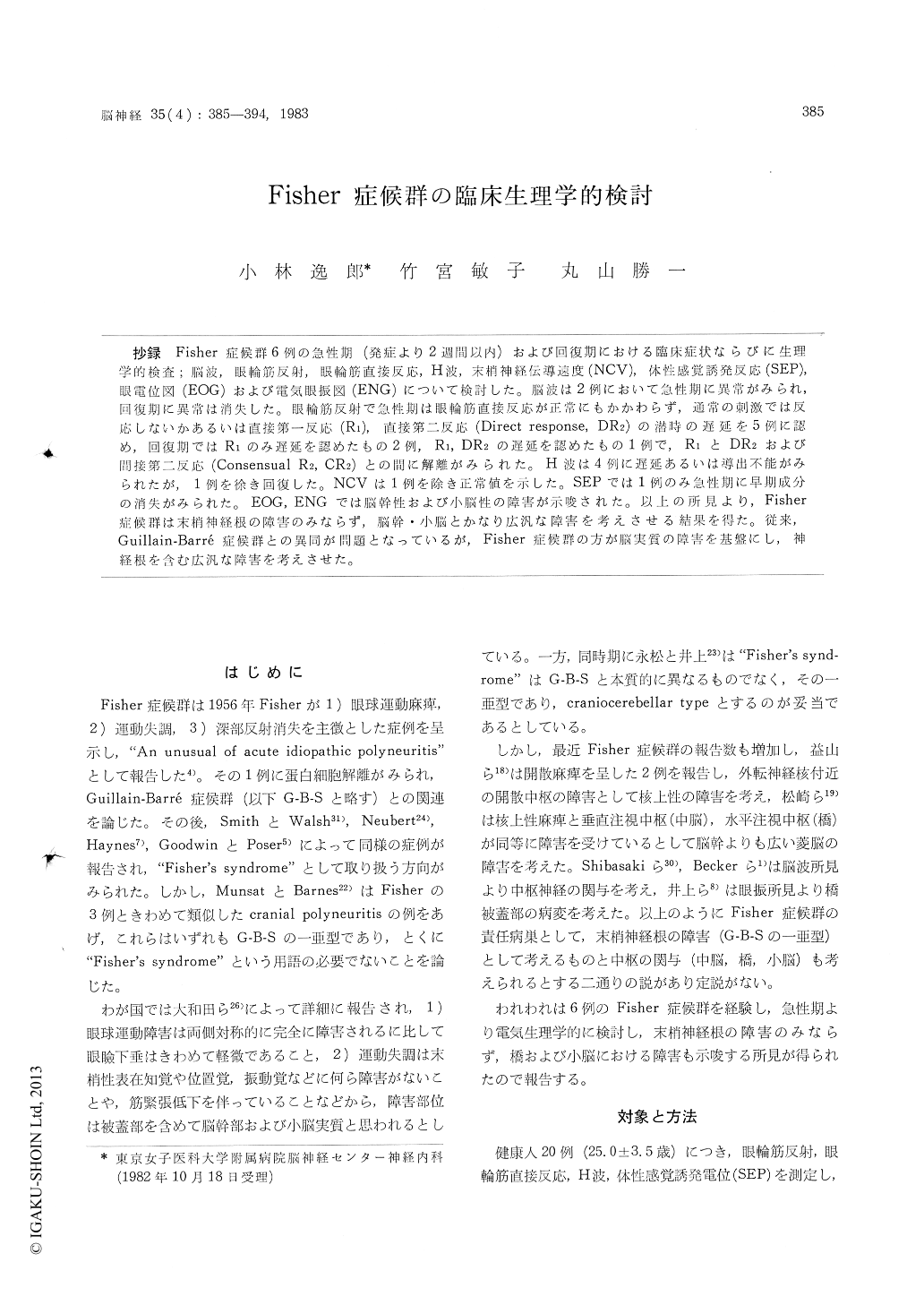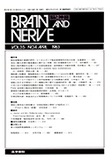Japanese
English
- 有料閲覧
- Abstract 文献概要
- 1ページ目 Look Inside
抄録 Fisher症候群6例の急性期(発症より2週間以内)および回復期における臨床症状ならびに生理学的検査;脳波,眼輪筋反射,眼輪筋直接反応,H波,末梢神経伝導速度(NCV),体性感覚誘発反応(SEP),眼電位図(EOG)および電気眼振図(ENG)について検討した。脳波は2例において急性期に異常がみられ,回復期に異常は消失した。眼輪筋反射で急性期は眼輪筋直接反応が正常にもかかわらず,通常の刺激では反応しないかあるいは直接第一反応(R1),直接第二反応(Direct response, DR2)の潜時の遅延を5例に認め,回復期ではR1のみ遅延を認めたもの2例,R1, DR2の遅延を認めたもの1例で,R1とDR2および間接第二反応(Consensual R2, CR2)との間に解離がみられた。H波は4例に遅延あるいは導出不能がみられたが,1例を徐き回復した。NCVは1例を除き正常値を示した。SEPでは1例のみ急性期に早期成分の消失がみられた。EOG, ENGでは脳幹性および小脳性の障害が示唆された。以上の所見より,Fisher症候群は末梢神経根の障害のみならず,脳幹・小脳とかなり広汎な障害を考えさせる結果を得た。従来,Guillain-Barré症候群との異同が問題となっているが, Fisher症候群の方が脳実質の障害を基盤にし,神経根を含む広汎な障害を考えさせた。
Fisher's syndrome, characterized by ophthal-moplegia, ataxia, and areflexia, has been discussed as being the probable lesions of three symptoms. The purpose of this study is to clarify the lesions and observe the physiological response in both the acute and recovery stages using blink reflex, H-reflex, facial nerve conduction time, peripheral nerve conduction velocity (NCV), somatosensory evoked potential (SEP), electrooculogram (EOG) and electronystagmogram (ENG).
The blink reflex, facial nerve condition time, H-reflex and SEP were studied on 20 cases of normal subjects and 6 cases of Fisher's syndrome who were examined in the acute and recovery stages. The acute stage means within 14 days from the onset. EOG and ENG were performed in the recovery stage.
The technique of performing the blink reflex was followed by Kimura's method. H-reflex was performed from the medical aspect of the soleus stimulation of the posterior tibial nerve in the popliteal fossa. SEP in response to median nerve stimulation was led through a scalp electrode placed just above contralateral hand sensory or motor cortex to an indifferent electrode on the prefrontal region.
(Blink reflex) The normal range of latency of the early reflex response, R1 was 10.4±0.7 msec. The latencies of the late reflex response, direct response (DR2) and consensual response (CR2) were 28. 5±3.7 msec. and 28. 2±2. 9 msec. on the left side, respectively. The latencies of DR2 and CR2 on the right side were 28.7±2.5 msec. and 27.6 ±2.4 msec.
(SEP) In the normal subjects, the response ap-peared to have 6 distinct peaks, beginnings with a small positive peak (P1) with latency of 14.0 msec. following by a negative peak (N1) with that of 18. 9 msec. and subsequent positive-negative sequences (P2 25. 1 ; N2 33.6 ; P3 45. 6 ; N3 65. 8 msec.).
Figure 6 shows the results of clinical symptoms of Fisher' s syndrome. All cases were revealed the internal and/or external ophthalmoplegia, ataxia and areflexia. Albuminocytologic dissocia-tion were found in 3 cases. Muscle weakness of the extremities was not seen in all cases. Slight facial diplegia and slight hypesthesia of the ex-tremities were seen in 3 cases.
(Case No. 1) In the acute stage, the blink reflex was absent or delayed response, whereas the facial nerve conduction time was 3.6 msec., this conduc-tion time was normal. In the recovery stage, the latency of R1 was delayed. The latencies of DR2 and CR2 were normal to slightly delayed. This data indicates that the latency of R1 was disso-ciated from the latencies of DR2 and CR2. H-reflex was prolonged even in the recovery stage. NCV was normal except for sural nerve conduction velocity. SEP showed the disappearance of P1 in the acute stage, and was recovered to normal in the recovery stage. EOG showed the ataxic pur-suit eye movement and hypermetria on the sac-cadic eye movement. ENG showed the lateral gaze nystagmus (Fig. 1).
(Case No. 2) The results of case No. 2 were close to case No. 1. In the acute stage, the res-ponses were absent. In the recovery stage, the latency of R1 was dissociated from DR2 and CR2. NCV and SEP were normal in the acute stage. EOG showed the hypermetria on the saccadic eye movement.
(Case No. 3) In the acute stage, the latency of Ri was 17 msec. in the right stimulation ipsilate-rally, whereas the latencies of DR2 and CR2 were normal. The prolongation of R1 was also disso-ciated from DR2 and CR2. NCV was normal in the recovery stage. EOG showed the hypometria in the saccadic movement. ENG showed the lateral gaze nystagmus.
(Case No. 4) The latencies of R1, DR2 and CR2 were normal in the acute and recovery stages. NCV and SEP were also normal. EOG showed the ataxic pursuit eye movement and hypometria on the saccadic eye movement. ENG showed the lateral gaze nystagmus.
(Case No. 5) In the acute stage, the blink reflex was not evoked or delayed response. In the reco-very stage, the latency of R1 recovered to normal range, the latencies of DR2 and CR2 were still delayed. NCV was normal in the both acute and recovery stages. SEP showed the prolongation of late component in the acute stage.
(Case No. 6) In the acute stage, EEG was abnormal and the latencies of R1 were within normal ranges, but the latencies of DR2 and CR2 were delayed. In the recovery stage, this changes recovered to normal. NCV and SCV were normal in the acute stage. EOG showed the hypometria on the saccadic eye movement.
In summary, two patients had EEG abnormali-ties that later improved. The EEG pattern sug-gested a brain stem disorder. The blink reflex showed no response and/or delayed the R1, DR2 and CR2 in the acute stage. The blink reflex showed the delayed response as only R1, and the normal response as DR2 and CR2 in the recovery stage. NCV and SEP were normal in the recovery stage. EOG was abnormal in the smooth pursuit eye movement and the saccadic eye move-ment. ENG showed the lateral gaze nystagmus.
These results plus the clinical symptoms imply that in Fisher's syndrome there is parenchymal involvement of the central nervous system with or without nerve root involvement.

Copyright © 1983, Igaku-Shoin Ltd. All rights reserved.


